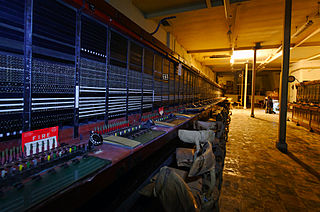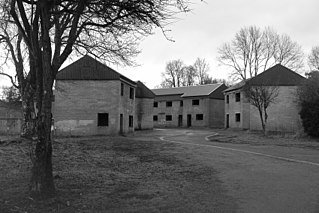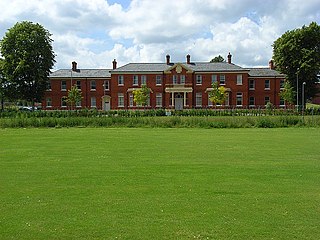 W
WIn 1911 the British War Office announced their first Military Aeroplane Competition for aircraft to meet the requirements of the newly formed Royal Flying Corps. The formal requirements were published in December 1911. The trials were held in August 1912 at Larkhill on Salisbury Plain, and the competition was won by S. F. Cody with his Cody V biplane.
 W
WBattlesbury Barracks is a British Army installation in Warminster, Wiltshire, England. It is the permanent base of The 1st Battalion, Yorkshire Regiment, serving as armoured infantry. The battalion is currently commanded by Lieutenant Colonel T J Miller.
 W
WThe Bulford Kiwi is a large depiction of a kiwi, carved in the chalk on Beacon Hill above the military town of Bulford on Salisbury Plain in Wiltshire, England. It was created in 1919 by soldiers of the New Zealand Expeditionary Force who were awaiting repatriation following the end of First World War.
 W
WThe Central Government War Headquarters (CGWHQ) is a 35-acre (14 ha) complex built 120 feet (37 m) underground as the United Kingdom's emergency government war headquarters – the hub of the country's alternative seat of power outside London during a nuclear war or conflict with the Soviet Union. It is located in Corsham, Wiltshire, in a former Bath stone quarry known as Spring Quarry, under the present-day MoD Corsham. In 1940, during the Second World War, the site was acquired by the Minister of Aircraft Production and used as an underground engine factory.
 W
WCopehill Down is a Ministry of Defence training facility near Chitterne on Salisbury Plain, Wiltshire, England. It is a 'FIBUA' urban warfare and close quarters battle training centre, where exercises and tests are conducted.
 W
WThe East Knoyle War Memorial is a monument that commemorates the lives of soldiers from East Knoyle, Wiltshire, England, who were killed in war. Unveiled on 26 September 1920, it was originally intended to commemorate the 20 soldiers from the parish who died during the First World War. Subsequent inscriptions were added to recognise twelve who were killed in the Second World War, and a soldier killed by friendly fire in the Iraq War. In 2016 the memorial was designated a Grade II listed building.
 W
WThe Battle of Ellendun or Battle of Wroughton was fought between Ecgberht of Wessex and Beornwulf of Mercia in September 825. Sir Frank Stenton described it as "one of the most decisive battles of English history". It effectively ended Mercian Supremacy over the southern kingdoms of Anglo-Saxon England and established West Saxon dominance in southern England.
 W
WAt the Battle of Edington, an army of the Anglo-Saxon kingdom of Wessex under Alfred the Great defeated the Great Heathen Army led by Guthrum on a date between 6 and 12 May AD 878, resulting in the Treaty of Wedmore later the same year. Primary sources locate the battle at "Ethandun", and until a scholarly consensus linked its location with the present-day Edington in Wiltshire it was known as the Battle of Ethandun, a name which continues to be used.
 W
WThe Fovant Badges are a set of regimental badges cut into a chalk hill, Fovant Down, near Fovant, in southwest Wiltshire, England. They are located between Salisbury and Shaftesbury on the A30 road in the Nadder valley; or approximately 1⁄2 mile (800 m) southeast of Fovant. They were created by soldiers garrisoned nearby, and waiting to go to France, during the First World War; the first in 1916. They are clearly visible from the A30 road which runs through the village. Nine of the original twenty remain, and are scheduled ancient monuments and recognised by the Imperial War Museum as war memorials. Further badges have been added more recently.
 W
WImber is an uninhabited village in part of the British Army's training grounds on the Salisbury Plain, Wiltshire, England. It is situated in an isolated area of the Plain, about 2 1⁄2 miles (4 km) west of the A360 road between Tilshead and West Lavington. The entire civilian population was evicted in 1943 to provide an exercise area for American troops preparing for the invasion of Europe during the Second World War.
 W
WThe Imber friendly fire incident took place on 13 April 1942 at Imber in the English county of Wiltshire during the Second World War. One of the Royal Air Force fighter aircraft taking part in a firepower demonstration accidentally opened fire on a crowd of spectators, killing 25 and wounding 71. Pilot error and bad weather were blamed for the incident.
 W
WLarkhill is a garrison town in the civil parish of Durrington, Wiltshire, England. It lies about 1 3⁄4 miles (2.8 km) west of the centre of Durrington village and 1 1⁄2 mi (2.4 km) north of the prehistoric monument of Stonehenge. It is about 10 mi (16 km) north of Salisbury.
 W
WMoD Corsham is a Ministry of Defence establishment located between the towns of Corsham and Box in Wiltshire, England.
 W
WNetheravon Airfield is a grass strip airfield on Salisbury Plain, in Wiltshire, England. Established in 1913 by the Royal Flying Corps, it became RAF Netheravon from 1918 until 1963, then AAC Netheravon until 2012. Buildings from 1913 and 1914 survive on part of the site.
 W
WProject Allenby Connaught is a scheme begun in 2006 to redevelop the military garrisons of Aldershot and Salisbury Plain in the United Kingdom. The project is named after Lord Allenby who served as a cavalry commander on Salisbury Plain, and the Duke of Connaught who was Commander-in-Chief at Aldershot Command.
 W
WRAF Hullavington was a Royal Air Force station located at Hullavington, near Chippenham, Wiltshire, England. The station opened in June 1937 and was predominately used for various training purposes. It closed on 31 March 1992 when it was transferred to the British Army and renamed Buckley Barracks. The airfield part of the site, known as Hullavington Airfield, continued to be used for RAF gliding operations until 2016 when it was sold to technology company Dyson.
 W
WThe Red Devils are the Parachute Regiment's parachute display team. The team wears the distinctive maroon beret. The Red Devils are regular serving paratroopers from the four battalions of the Parachute Regiment who have volunteered to serve on the display team.
 W
WThe Battle of Roundway Down was fought on 13 July 1643 near Devizes, Wiltshire, during the First English Civil War. A Royalist cavalry force under Lord Wilmot won a crushing victory over the Parliamentarians under Sir William Waller.
 W
WThe Royal School of Artillery (RSA) is the principal training establishment for artillery warfare in the British Army. Established in 1915, it is located at Larkhill, Wiltshire, on the south edge of Salisbury Plain in the United Kingdom. The School is the primary training facility for Royal Artillery recruits, and is also home to the Gunnery Training Team.
 W
WSalisbury Plain is a chalk plateau in the south western part of central southern England covering 300 square miles (780 km2). It is part of a system of chalk downlands throughout eastern and southern England formed by the rocks of the Chalk Group and largely lies within the county of Wiltshire, but stretches into Berkshire and Hampshire. The plain is famous for its rich archaeology, including Stonehenge, one of England's best known landmarks. Large areas are given over to military training and thus the sparsely populated plain is the biggest remaining area of calcareous grassland in northwest Europe. Additionally the plain has arable land, and a few small areas of beech trees and coniferous woodland. Its highest point is Easton Hill.
 W
WWardour Castle in Wiltshire was besieged twice during the First English Civil War; once in May 1643, and then again between November 1643 and March 1644. During the first siege, a Parliamentarian force of around 1,300 men led by Sir Edward Hungerford attacked the castle, which was the home of Thomas Arundell, 2nd Baron Arundell of Wardour, a prominent Catholic and Royalist. Arundell was absent, fighting for King Charles at the time of the attack, and the defence was led by his wife, Lady Blanche Arundell, in command of 25 soldiers. The siege was started on 2 May, and lasted for a week before the Parliamentarians forced Lady Arundell to surrender on 8 May. The Parliamentarians garrisoned the castle with 75 men, led by Colonel Edmund Ludlow.
 W
WSwinton Barracks is a military installation accommodating two engineer regiments at Perham Down in Wiltshire, England. The site is on the east edge of Salisbury Plain, about 1 1⁄2 miles (2.4 km) east of the garrison at Tidworth.
 W
WTidworth Garrison is a military installation at Tidworth in Wiltshire, England.
 W
WWaterloo Lines, formerly known as the Land Warfare Centre, is a British Army barracks on Imber Road in Warminster, Wiltshire, England. It is currently home to a number of Army specialist training schools and a sizeable portion of the Headquarters Field Army, not to be confused with Army HQ in Andover.